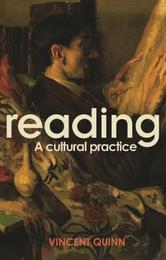
|
Reading: A Cultural Practice
Hardback
Main Details
| Title |
Reading: A Cultural Practice
|
| Authors and Contributors |
By (author) Vincent Quinn
|
| Series | Manchester University Press |
|---|
| Physical Properties |
| Format:Hardback | | Pages:224 | | Dimensions(mm): Height 234,Width 156 |
|
| Category/Genre | Literary theory
Literary studies - general |
|---|
| ISBN/Barcode |
9781526136947
|
| Classifications | Dewey:809 |
|---|
| Audience | |
|---|
| Illustrations |
4 black & white illustrations
|
|
Publishing Details |
| Publisher |
Manchester University Press
|
| Imprint |
Manchester University Press
|
| Publication Date |
12 June 2020 |
| Publication Country |
United Kingdom
|
Description
Why do we read, and have we always read in the same way? Reading: A cultural practice uses a rich variety of literary and visual sources to explore how reading has changed, and continues to change, in response to new technologies and shifting social pressures. Drawing on medieval illustrations, classic fiction, the art and literature of the Bloomsbury Group, and contemporary e-culture, the book shows that there is no single, unchanging thing called 'reading'-instead, it is something that mutates over time. Throughout history, ways of reading, and theories of reading, have been shaped by religious and educational institutions. This continues to be true, but current approaches to reading are also conditioned by debates over digital culture and social media use. Reading: A cultural practice re-frames these contemporary preoccupations by offering a long view on how our notions of books and reading alter according to social and historical context. -- .
Author Biography
Vincent Quinn is a Research Fellow in English at the University of Sussex -- .
Reviews'Quinn provides an interesting treatise on the relationship between reading and literature, history and critical theory. In six chapters supported by extensive endnotes and an impressive bibliography, Quinn covers the history and protocols of literary criticism from Greek theorists to biblical references and classic literature to contemporary writers of young adult fiction... the last two chapters offer a fascinating discussion of "post-truth" and the relationship between reading and technology. Quinn has an interesting view of the relationship between reading and cultural practices.' CHOICE Reprinted with permission from Choice Reviews. All rights reserved. Copyright by the American Library Association -- .
|